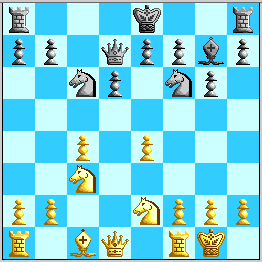
All diagrams have been cut-and-pasted from MacChess 5.0.1 using Screen Catcher 1.0.
This article is copyright 1999 by:
R&D (Chess) Publishing
Irina Krush
Kenneth W. Regan
All Rights Reserved
Earlier this year, the public relations company working for Microsoft approached my friends at smartchess.com and asked if I would like to participate in the planned "Kasparov vs. the World" match to be held over the Internet on the MSN Gaming Zone (zone.com). Apparently the World Champion had suggested that some junior players be involved in the event as World Team coaches. I was to be one of four players who would advise players all over the world as to how they should cast their votes for moves to be played against Kasparov. Also participating were GM Etienne Bacrot (France), FM Florin Felecan (USA), and WIM Elisabeth Paehtz (Germany).
On June 21st, 1999 I was invited to take part in the Opening Ceremony at Bryant Park in New York City attended by Kasparov and MSN Moderator GM Danny King (England). Here's how the game worked. Every other day, Garry Kasparov made his move, which was posted at 3:00 PM EST. Kasparov's first move (on June 21) was 1.e4. The four World Team (WT) Coaches and Danny King offered their commentaries on the game and recommended moves (except Danny King whose role as a moderator was supposed to be to add color commentary and background). These recommendations also appeared at 3:00 PM EST along with Kasparov's move. The World Team players sent in their votes via e-mail between 3:00 PM EST of that day and 9:00 AM EST of the next morning, at which time the votes were tabulated. The winning move and the four runners-up were announced on the live site at 3:00 PM EST. Microsoft was predicting that the event would become the largest ever interactive event held on the Internet. Even Microsoft (as hosts and organizers) and First USA (the sponsors) must have been astonished at the massive publicity extravaganza that the event became over the next four months.
Kasparov, G. - The World
MSN Gaming Zone 1999
Sicilian Defense B52
This has been Garry's most usual opening move when he means business.
I felt that the Sicilian Defense would create an interesting and dynamic game for this historic event.
The usual move. I did not expect Garry to deviate from a normal Open Sicilian (following up with 3.d4).
It was not surprising that all of the Official Analysts recommended 2...d6 - based on a look at their opening repertoires. In fact it seemed likely that we would be heading for a Najdorf Variation - Garry's own favorite defense when playing Black.
Something of a surprise as this move features only rarely in Garry's play. Apparently Kasparov was worried about divulging any of his preparation for his scheduled match with Vishy Anand - in other words finding himself in a theoretical duel in the Najdorf.
In an e-mail, Garry even went so far as to ask (the WT coaches) for forgiveness for playing, in his words, the "unattractive" 3.Bb5+.
The most solid move. I preferred the sharper and more combative 3...Nd7 when Black both avoids any weakening in the pawn structure, and simplification can result in Black obtaining the bishop pair at the cost of a small lag in development. Also possible is 3...Nc6.
The only real choice as after 4.a4 Nc6, and I do not see what the advance of White's a-pawn has achieved, while after 4.Qe2 Bxb5 5.Qxb5+ Qd7, Black has an easy game.
Instead 4...Nxd7 is a less resilient option, as Black will have less influence over the d4-square.
5.0&endash;0 is the main alternative, for example: 5...Nc6 6.c3 Nf6 7.d4, is an interesting gambit idea (also possible is 7.Re1 defending e4 and planning to build a center with d2-d4) 7...Nxe4 8.d5 Ne5 (best) 9.Re1 Nxf3+ 10.Qxf3 Nf6 11.c4 e5 12.dxe6 fxe6 13.Bg5, when White had compensation and pressure for his pawn in Adams-Anand, Groningen FIDE KO, 1997.
Black continues development and aims to fight for the central squares d4 and e5.
Instead 5...Qg4?! is a very risky pawn snatch, not to be recommended against a player like Kasparov. After 6.0&endash;0 Qxe4 7.d4, White has a very strong initiative and attack in compensation for the pawn.
6. Nc3 Nf6
The theoretical alternative is 6...g6! as preferred by Kasparov himself. For example, after 7.d4, Kasparov introduced 7...Bg7!? 8.d5 Bxc3+ 9.bxc3 Na5, against Shirov at the 1996 Erevan Olympiad. Shirov analyzes this game in detail on his "Best Games Vol. 4" video. Shirov played 10.0&endash;0, but the later game Rublevsky-Ehlvest, Polanica Zdroj 1997 continued 10.Nd2 and that game has placed Kasparov's idea under pressure. Ore usual is 7…cxd4 8.Nxd4 Bg7 9.Nde2 (9.Be3 is maybe a little better) 9...Nf6 10.0&endash;0, transposing to our game.
7. 0-0
Continuing with his development. If 7.d4 cxd4 8.Nxd4 Qg4, and Black should equalize easily. This is one naive idea behind 6...Nf6.
7. ... g6
This is the most active defense for Black. Another way to play which is solid but more passive is 7...e6 8.d4 cxd4 9.Nxd4 Be7, with a Scheveningen-type set-up of central pawns on d6 and e6. Black must endure a spatial disadvantage and carefully prepare counterplay with the traditional pawn breaks b7-b5 (after a7-a6) and d7-d5.
8. d4 cxd4
9. Nxd4 Bg7
Black completes the development of his minor pieces by bringing his bishop to the a1&endash;h8 long diagonal. Black is now threatening 10...Nxe4, unveiling an attack on White's knight on d4, so White must now address this threat.
10. Nde2

All diagrams have been cut-and-pasted from MacChess 5.0.1 using Screen Catcher 1.0.
The main alternative is 10.Nc2 (bringing the knight to e3). I actually indicated in one of my posts to the MSN and www.smartchess.com sites that this move may be the direction Garry was heading (rather than 10.Nde2). I was actually hoping Garry would play 10.Nde2 as I had something prepared in that variation. Note that 10.Nxc6 Qxc6 is an easy game for Black.
After 10.Nde2, the standard continuation had been the mundane 10...0&endash;0, when White can play Bc1-e3, f2-f3, Qd1-d2 connecting rooks and White has enjoyed a positional edge in many of the recent games in this line.
For example: 10…0-0 11.f3 a6 (11…Rfc8 may transpose after 12.Be3 Qd8 13.b3 a6 14.a4) 12.a4, and now:
A) 12…Rfc8 13.b3 Qd8 14.Kh1 Nd7 15.Bg5 Qa5 16.Qd2 Nc5 17.Rab1 e6 18.Rfd1, with a positional advantage for White, Kramnik-Gelfand, Sanghi Nagar, (m/3) 1994.
B) 12…Qd8 13.Be3 Qa5 14. Kh1 Rfd8 15.Nd5 Nxd5 16.exd5 Ne5 17.b3, Rublevsky-Gelfand, Polanica Zdroj 1998.
When Garry played 10.Nde2, he "tongue-in-cheek" mentioned he was playing his knight to the more traditional square on e2 (not as Ms. Krush expected!). This gave WT the opportunity to spring a surprise on the World Champion, something I had been studying for over a week.
10. ... Qe6!
"A great move, an important contribution to chess," - Garry Kasparov.
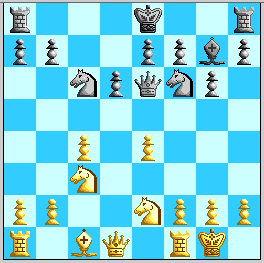
While playing at the World Open in Philadelphia I had shown this theoretical novelty - which I had discovered while looking at some positions on an old pocket chess set - to my trainers GM Giorgi Kacheishvili and GM Ron Henley (the latter via phone). I had been looking at various options for Black in the eventuality that WT played the line 6…Nf6 7.0-0 g6, instead of 6…g6 (the move order I had preferred and which would likely have reached a different position). After exchanging some ChessBase files with my friends at smartchess.com and introducing the idea on the MSN Bulletin Boards, I e-mailed my fellow analyst Elisabeth Paehtz informing her of my intention to propose this new idea to the World Team's voters. As it turned out 10…Qe6 won the vote by a narrow margin. The new move, 10…Qe6, is a dynamic solution for Black and is a clear improvement on 10…0-0.
White has two real ways (11.Qb3 or 11.Nd5) to meet the simultaneous attack on his c- and e-pawns (there is no compensation for White if he jettisons his c-pawn with 11.f3 Qxc4). I was pleased that 10…Qe6 had also earned the important and independent endorsement from the strong Russian GMs Alexander Khalifman and Konstantin Sakaev of the Grandmaster Chess School in St. Petersburg, Russia. As the game progressed, I would do a lot of study with Alexander (who took a time-out during the game to win the FIDE World Championship in Las Vegas!) - probably more than with any other player excepting my own trainers.
After a posting by me - this new line became known as the "World Variation". A few players had lobbied for the line to be called the "Krush Variation" - but I did not find such an idea to be in keeping with our team spirit. Soon, I found the concept of people jockeying and arguing to name moves and variations after themselves in this event to be nauseating - some sources were even naming Kasparov's moves after themselves!
11. Nd5!
This is the most direct and aggressive move for White - "threatening" the fork on c7 - a fork which has obviously been invited. Moderator Danny King (after the game) went as far as to say that Garry underestimated the power of 10...Qe6, and that Kasparov even felt he was fighting for a draw. However, I do not believe that White ever stood worse in this game, and Garry consistently found strong and testing moves. We could not expect or wish for anything less.
The alternative 11.Qb3 is not a serious issue for Black, for example, 11…0&endash;0! and now:
A) 12.Qxb7?! Rfc8 13.Qa6 Nxe4 (13...Nb8!? is amusing as after 14.Qb7 Nc6! There is already the possibility of a draw by repetition) 14.Nf4 Qf5 15.Ncd5 Qd7, and Black has an edge.
B) 12.Nf4 Qd7, and Black has a comfortable game as White has simply misplaced his queen.
Finally, after 10...Qe6, what if White tries (in gambit-style) the move 11.Nf4?! Black can calmly play 11...Qxc4, and here is a sample variation: 12.Nfd5 0-0 13.b3 Qc5, and if 14.Be3 (14.Na4 Qa5 15.Bd2 Qd8 maintains an extra pawn for Black), Black has the beautiful queen sacrifice 14...Nxd5!! and now:
A) 15.Nxd5 Qa3 16.Rc1 (16.Bc1 Qa6! 17.Nc7 Qa5 18.Nxa8 Bxa1 19.Bd2 Qxa2, and Black wins, for example: 20.Qxa1 Qxa1 21.Rxa1 Rxa8, or 20.Nc7 Bg7 when in each case, Black has two extra pawns) 16...Qxa2 17.Rxc6 bxc6 18.Nxe7+ Kh8, is winning for Black.
B) 15.exd5 Qxc3 16.Rc1 Qb2 17.Rc2 (17.dxc6 bxc6 is good for Black) 17...Qa3 18.dxc6 bxc6, with a clear plus for Black.
C) 15.Bxc5 Nxc3 16.Qe1 dxc5 17.Rc1 Nxa2 18.Rxc5 Rfd8, with a clear advantage for Black - three minor pieces and a pawn (a material advantage) - plus lots of board control in return for the queen.
11. ... Qxe4
Actually forced. There is no turning back. Black is sacrificing the Exchange but in return Black destroys White's central control by wiping out White's two central pawns.
Black must follow through as after 11...0&endash;0?! 12.f3! White is fortifying e4 and leaving Black's queen looking silly.
12. Nc7+ Kd7
13. Nxa8
The forced moves continue. White captures the rook, but note that the White knight is trapped and does not need to be captured immediately.
13. … Qxc4
14.Nb6+
Rather than allow Black to play Rh8xNa8, when Black keeps a beautiful pawn structure and has two central pawns and a knight for the rook with no weaknesses, White desperadoes his knight to inflict some pawn weaknesses on Black.
14. ... axb6
15. Nc3!
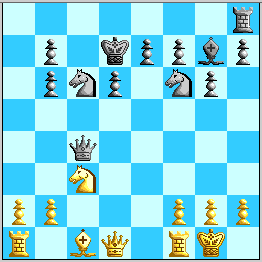
This is clearly the strongest move for White. Instead, after 15.b3 Qd5! 16.Bb2 Qxd1 17.Rfxd1 Rg8! the endgame offers equal chances, while after 15.Be3 Nd5! all of Black's pieces are active and well placed, and Black has at least equal chances, for example: 16.Qd2 Nxe3 17.Qxe3 Qc5 18.Qb3 (18.Qf3 Bxb2 19.Rab1 Bf6 20.Qb3 d5 21.Qxb6 Qxb6 22.Rxb6 Kc7 23.Rfb1 Rb8, and White has not equalized) 18...e6 19.Rac1 Qb4 20.Qf3 Ke7 21.a3 Qb5, with an edge for Black.
As we can consider the game to be actually starting from this moment (after 15.Nc3), it is worthwhile taking pause and examining the strategic aspects of this position.
Material: The sides have material equality - Black has a knight + 2 pawns for a rook. However, this dynamic material balance creates different strategic problems for each side.
King Safety: White's king is safely tucked away on the kingside. Black's king is in the center, behind his wall of center pawns (Black's extra pawns as a result of the volley of forced moves that have occurred since move 10). We are taught early in our chess careers that leaving the king in the center of the board during the opening phase of the game is not a wise course to follow. However, there are exceptions to every rule, and for the short term while White is lagging in development, Black's king is apparently not exposed to any imminent knock-out blow.
Piece Activity and Development: Black, for the time being, has a lead in development. This is a direct consequence of Garry's forced knight raid to a8. No less than nine of Garry's first fifteen moves have been knight moves (Ng1-f3xd4-e2-c3, and Nb1-c3-d5-c7xa8-b6)! Note also three moves by White pawns (none of which are on the board anymore), and two moves by a White bishop (since departed). This opening is very unusual, don't you think?
Black's pieces are active - Black's queen is centralized; Black's dark squared bishop holds sway over the a1-h8 diagonal; Black's knights control key central squares, and further centralization is possible (e7-e6, Nf6-d5). Black's rook is poised to enter the action - for example at a8 or d8 as circumstances dictate. For the moment, White has a compact but solid position confined to his first three ranks. White has yet to connect his rooks, and it is not yet clear how he should post his queen. In order for White to be able to take the initiative, he must find a way to activate his heavy pieces (queen and rooks). Although the c-file is open, and the d- and e-files are half-open, Black's plans include the neutralization of the White rooks by blocking the center with his pieces and pawns - for example with e7-e6 and Nf6-d5.
White has to make some decisions regarding his queenside pawn structure - can he create open lines for his rooks on the queenside - for example, by playing a2-a3 in response to the advance of a Black pawn to b4, or will this merely allow Black to liquidate his weakness, and reduce White's opportunities for an advantage?
Pawn Structure: For the moment, White enjoys a slight advantage in pawn structure. White has two compact pawn islands. Black has a solid array of pawns stretching along d6-e7-f7-g6-h7. However, Black has doubled b-pawns. This latter deficiency is partly compensated for by the fact that Black can pressure White's queenside pawn structure along the half-open a-file and the a1-h8 diagonal. Black can also use his front b-pawn to gain space on the queenside, and in certain circumstances rid himself of the doubled pawn by exchanging it for White's a-pawn.
The absence of White center pawns reduces White's chances for an attack on the Black king, as White has no central pawn levers with which to attack Black's central pawns. White's attacking chances primarily lie in active piece play.
15. … Ra8
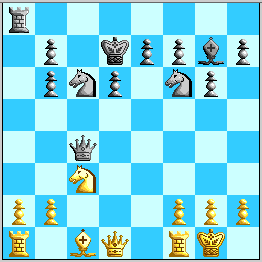
Originally proposed by GM Jonathan Speelman - this is not Black's only method to generate counterplay. This piece activation idea has been maligned in some circles - but I don't buy the arguments even though this development of Black's rook to the half-open a-file provokes a strong (and perhaps necessary) response from Kasparov. Black's idea is to activate the rook with the unusual maneuver Ra8-a5-f5.
After 15.Nc3, Black has two other serious options for consideration. Let's take a look at them.
My original intention when proposing 10…Qe6 to the World Team, was the space-gaining 15...b5!? and now:
A) 16.Be3 Ra8!? would transpose to the possible variation 15...Ra8!? 16.Be3 b5.
B) 16.Bg5 Ne4 17.Nxe4 Qxe4 18.Re1 Qf5 19.Qd2 (19.Be3 h5!? is equal) 19...Ra8 (19...h6!?) 20.Rad1 Be5, with equal chances.
C) 16.a3 Ne4! and now:
C1) 17.Nd5 Qd4, and Black has completely equalized, or;
C2) 17.Nxe4 Qxe4 18.Re1, when Black has the pleasant choice of 18…Qc4! or 18...Qf5!? 19.Qe2 e6 20.Be3 h5!? with a nice game in either case.
D) 16.Qf3 b4 17.Na4 Qb5 18.Qh3+ e6 19.Bh6 Bxh6 20.Qxh6 Rd8 21.b3 Qh5 22.Qxh5 Nxh5, is equal.
After 15…b5!? White's most dangerous and direct line is:
E) 16.Re1! b4! 17.Na4 Qb5, when I first expected:
E1) 18.Be3 e6! 19.Rc1 (19.Nc5+ Ke7 20.Nb3 Ra8, or 19.Nb6+ Ke7 20.Rc1 Rd8, are fine for Black) 19...Nd5, when Black has excellent prospects, for example 20.b3?! Nc3 21.Nb6+ (21.Nxc3? bxc3, is obviously good for Black) 21...Ke7 22.Qd2 Ne4! 23.Qe2 Qxe2 24.Rxe2 d5, and Black is better. Then I saw and feared:
E2) 18.a3 Rd8 19.axb4 Qxb4 20.Re3!? with dangerous attacking chances. The position is not clear, and the unresolved difficulties in this line were sufficient to deter me from recommending 15…b5 to my teammates. However, the recently suggested improvement 19...Ke8!? appears to give Black a very comfortable game.
Black's second alternative is 15...Rd8. This was in fact GM Ron Henley's original suggestion to me when I showed him the 10…Qe6 analysis from Philadelphia. It is certainly logical to centralize the rook behind Black's center pawns, preparing to evacuate the Black king to e8 and then f8. As the deadline approached for submission of my 15th move recommendation for Black, only one line remained unresolved.
A) 16.Be3 b5!? 17.Rc1 (17.a4 b4 18.Nb5 Nd5, is equal) 17...b4 18.Na4 (18.b3 Qa6, favors Black) 18...Qb5, and Black has a comfortable position.
B) 16.Bg5 Ke8 17.Rc1 Qb4 18.b3 Qa5 19.Bxf6 Bxf6 20.Nd5 Bd4, and Black stands a little better.
C) 16.Qf3!? Ke8, is equal.
D) 16.Re1 Ke8, and now:
D1) 17.Be3 Qb4!? 18.a3 (18.Qb3 Qxb3 19.axb3 Nd7, with an equal game) 18...Qxb2 19.Na4 Qb5 20.Rb1 Qf5 21.Rxb6 Rd7 22.Qb3 Na5 23.Qb1 Qxb1 24.Rexb1 Ng4 25.R6b5 Nc4 26.Rxb7 Rxb7 27.Rxb7 Ngxe3 28.fxe3 Nxa3, and Black holds an edge in the endgame.
D2) 17.Bg5!? d5! 18.Rc1 Kf8 19.b3 Qc5 20.Qd3 d4, and Black has equalized.
My concern was the variation with 16.Na4!? The solution was found after the deadline, but is elegant and demonstrates why 15…Rd8 is an acceptable alternative for Black (in my opinion).
E) 16.Na4!? Qb5!? 17.Be3 Ke8 18.Rb1 (after 18.Nxb6 Qxb2, or 18.Re1 Nd5 19.Bd2 Qc4! Black is OK) 18...d5, and now:
E1) 19.Bxb6 Ra8 20.b3 d4 21.Bc7 (White is lost after 21.Bxd4 Rd8) 21...Nd5 22.Bg3 Nc3 23.Nxc3 dxc3 24.a4 Qf5! and Black has excellent compensation.
E3) 19.Nc3 Qa5 20.Bd4 Kf8 21.b4 Qa3 (21...Nxb4?! 22.Qb3 e5 23.Bxe5, is good for White) 22.Nb5 Qxa2 23.Bxb6, when the position is somewhat unclear. As it turned out the sufficient 15…Ra8!? carried the vote, and Kasparov brought the heat with….
16. a4!
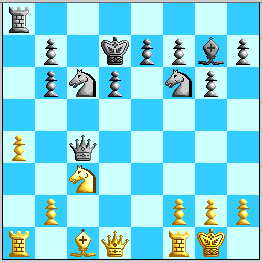
A strong move - the point of which would appear lost on some players. The advance of the White a-pawn combines elements of both attack and defense and, as we shall see, is aimed against a number of Black's possibilities.
White's alternatives offer him no initiative.
After 16.Re1, Black's main idea can be seen in full glory with 16...Ra5, for example: 17.a4 (17.Be3 Nd5 18.Nxd5 Rxd5 19.Qe2 b5 gives Black excellent counterplay) 17...Rf5! with dynamic play for Black, as Black's rook becomes very active and menacing.
Harmless is 16.Qf3, and after 16...Qg4 17.Qe3 (17.Qxg4+ Nxg4, is equal, and after 18.Nd5 Ra6, Black's chances are even favorable) 17...Qd4!? 18.Qe2 (18.Qxd4 Nxd4, is equal) 18...Nd5, and Black is well placed.
Weak for White is 16.Bg5?! Ra5 17.Bxf6 (17.Qd2 Nd5! is good for Black) 17...Bxf6, with an excellent position for Black.
The only serious alternative for White was 16.Be3, but Black obtains excellent prospects after 16…b5! For example:
A) 17.Rc1 Ke8 18.b3 (18.Bg5 Qd4, is equal) 18...Qh4, and now:
A1) 19.Nxb5 Rxa2 20.Rc4 Qh5 21.Qxh5 (21.Ra4 Qxd1 22.Rxd1 Rb2, is equal) 21...Nxh5 22.Ra4 Rb2, with equal chances.
A2) 19.Qd3 allows Black terrific counterplay with 19...Ng4!?
A3) 19.Qe2 Qh5, is fine for Black, for example: 20.Qxb5 Qxb5 21.Nxb5 Rxa2, with even chances.
B) 17.Re1 e6! and now:
B1) 18.Rc1 Nd5! 19.Qf3 (19.Nxd5 Qxd5 20.Qxd5 exd5 with advantage to Black) 19...Ne5 20.Qh3 Nxc3 21.Rxc3 Qg4, and Black has the initiative. Note that 22.Qxh7?? loses immediately to 22…Rh8.
B2) 18.a3 allows 18...Ng4! and White has problems, for example: 19.Bd2 f5!? 20.Qf3 (20.h3 Nge5 21.b3 Qd3 22.Re3 Qd4 23.Nxb5 Qxa1 24.Qxa1 Nf3+ 25.Rxf3 Bxa1 is good for Black) 20...Bd4, and Black is better.
Finally, after:
C) 17.a3 Ke8 18.Rc1 b4!? 19.b3 Qg4 (also possible is 19...Qa6!? 20.axb4 Nxb4) 20.Nb5 Kf8, Black has excellent prospects, for example: 21.a4 (21.Qxg4 Nxg4 22.axb4 Nxe3 23.fxe3 Bh6! 24.Rc3 Nxb4 25.e4 Nc6, favors Black) 21...Qxd1 22.Rfxd1 Ne4! and Black has an excellent position (as the c3-square beckons).
Another possibility after 16.Be3 is Speelman's original idea with 16…Ra6!? when after 17.Rc1, I like 17…Ng4!? (Speelman gave 17…Ne4, but I think White stands a little better after 18.Nxe4 Qxe4 19.Qb3 Qe6 20.Rc4 Bxb2 21.Bxb6 Bg7 22.Be3), and now:
A) 18.Bxb6 Nxh2! 19.Re1 (19.Kxh2 Rxb6, is good for Black) 19...Qg4! 20.Be3 Qxd1 21.Rexd1 Ng4, and Black is better.
B) 18.a3 Nxe3 19.fxe3 Qe6, equal.
C) 18.b3 Nxe3 19.fxe3 (19.bxc4 Nxd1 20.Rfxd1 Bxc3 21.Rxc3 Rxa2, with a clear plus for Black) 19...Qe6, equal.
D) 18.Nd5 Qe4, and now:
D1) 19.Nxb6+ Ke8 20.Nd5 (20.Qd5 Qxd5 21.Nxd5 Rxa2, favors Black) 20...Nxe3 21.Nxe3 Rxa2, with an edge for Black.
D2) 19.f3? is bad because of 19…Nxe3 20.fxe4 Nxd1 21.Rcxd1 Rxa2 22.Rxf7 Bxb2 23.Rxh7 (23.Nxb6+ Ke6 24.Rxh7 Bd4+ 25.Rxd4 Nxd4, is good for Black) 23...b5, with advantage to Black.
D3) 19.Re1 Nxe3 20.Rxe3 Qd4 21.Rd3 Qxb2, favors Black, when 22.Nxe7? fails to 22…Rxa2 23.Rxd6+ Kxe7, and Black wins.
D4) 19.Bxb6 e6 (now the bishop on b6 feels "cold"), with:
D41) 20.Nc3 Bxc3 21.Rxc3 (21.bxc3? loses to 21…Rxb6 22.f3 Qe3+) 21...Rxb6 22.f3 Qd4+ 23.Qxd4 Nxd4 24.fxg4 Ne2+ 25.Kf2 Nxc3 26.bxc3 Ke7, and Black wins.
D42) 20.f3 Qxd5 21.Qxd5 exd5 22.fxg4 Bxb2 23.Rxf7+ Ke6 24.Rc2 Rxb6, and Black wins.
D43) 20.Ne3 Rxb6 21.Qxg4 (21.Nxg4 Rxb2, with an edge for Black) 21…Qxg4 22.Nxg4 Rxb2 23.Rb1 b6!? (23...Rxb1 24.Rxb1 Kc7, is slightly better for Black) 24.Rxb2 Bxb2 25.Rb1 Bd4, and Black is at least equal.
So it would appear that Black has two interesting ways to meet 16.Be3, viz., 16…b5, and 16…Ra6.
In my opinion, Kasparov chose by far the strongest continuation with 16.a4! Kasparov's idea not only aims to fix Black's pawns (a la Nimzovich), but also aims to shut out Black's rook after 16…Ra5 17.Nb5! i.e., an attempt at two strategic refutations of Black's play at once!
16. … Ne4!
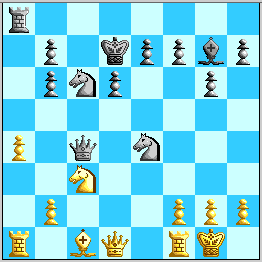
GM Jonathan Speelman referred to this as the most principled move. Strategically it is a good move as it forces the exchange of White's only developed piece and unmasks Black's potent bishop on g7.
I had concentrated initially on the variations 16…Ra5 and 16…Nd4 (the latter to exploit the newly created holes on b3 and b4), but an e-mail from GM Alex Khalifman (correctly criticizing one of my evaluations in the 16…Nd4 variation) gently persuaded me to more seriously consider 16…Ne4. After some late night analysis with my trainer GM Giorgi Kacheishvili, my attention returned to fleshing out some of my own ideas in the 16...Ne4 variation. I still remember how we selected this best move for not the best reason!
Kasparov's 16.a4! has a nasty point against Black's 16th move alternatives, and as we shall see, its effects persist over the next few moves.
After 16...Nd4 17.Be3 (After 17.Bg5 Nd5 18.Re1 e6 19.Nxd5 Qxd5, or 17.Ra3 b5!? 18.Nxb5 Nxb5 19.axb5 Rxa3 20.bxa3 Qxb5, Black should be OK) 17...Nd5, and now:
A) 18.Qg4+ f5 19.Nxd5 Qxd5 20.Qh3 h5!? 21.Bxd4 (21.Rfd1 Rxa4! 22.Bxd4 Rxa1 23.Rxa1 Bxd4, is good for Black) 21...Bxd4 22.Qg3 Qf7 23.Qd3 e5, and Black is OK. However, Black's problems in this variation stem from:
B) 18.Nxd5 Qxd5 19.Ra3! (once again White is putting the move 16.a4! to work) 19…Qc4 20.Rd3 Nf5 21.b3, and White has pressure.
If 16...Ra5?! 17.Nb5! (shutting out the Black rook) 17…Nd5 (in compensation, Black entrenches his knight in the center, but it is not enough), and now:
A) 18.b3 Qh4 19.Rb1 e6 20.Bb2 is a nuisance for Black, exchanging our nice bishop on g7. After 20...Bxb2 21.Rxb2 Ra8, Black should hold, but White can make some pressure. Instead White has the even better:
B) 18.Re1! e6 19.Ra3! (That move 16.a4! again). This seems very strong to me. White will bring his rook to d3 or f3 or even h3, and play b2-b3, and Black's rook on a5 will look stupid.
The plan of evacuating the Black king to the kingside with 16...Ke8!? was an idea that also met with a strong Ra1-a3 motif, after 17.Re1! Kf8 18.Be3 (18.Bg5 is also playable) 18...Qb4 19.Ra3! and now:
A) 19...Qxb2?? loses to 20.Rb3.
B) 19...d5 20.Rb3 Qc4 21.Bxb6 (21.Rxb6 d4 22.Rxc6 Qxc6 23.Bxd4 Rd8, is OK for Black) 21...d4 22.Ne2, and White's advantage is clear.
C) 19...Na5 20.Re2, and White has a positional advantage.
Despite finding a strong response with 16…Ne4, the World Team would still have to dodge another bullet or two from the 16.a4! gun.
17. Nxe4
White has no realistic way to avoid this continuation. After 17.Nd5 Bd4 18.Ne3 Qe6, Black has no problems.
If 17.Qg4+?! f5! and Black seizes an advantage with 18.Qh4 Nd2! 19.Qxc4 Nxc4.
If 17.Nb5 trying to avoid exchanges then 17…Nd4! 18.Nxd4 Bxd4 19.Be3 (19.b3 Qc5 20.Ba3 Bxf2+ 21.Kh1 Qg5 is good for Black) 19...Bxe3 20.fxe3 f5, and Black is better.
The most interesting line was the endgame following 17.Qd5 Qxd5 18.Nxd5 Ra6 19.Be3 Nc5. White is treading on thin ice. For example:
A) 20.b4 Bxa1 21.Rxa1 e6! and now:
A1) 22.Nf6+ Ke7, with:
A11) 23.Bg5 h6! 24.Nd5+ Kd7 25.Nf6+ Kd8 26.b5 Ra8! 27.Bxh6 Nd4, with advantage to Black.
A12) 23.Ng8+ Kf8 24.bxc5 Kxg8 25.cxd6 (if 25.cxb6 d5 26.Bc5 Na5 27.Rb1 Nc4 28.Rb4 e5, and Black plays f7-f6, followed by Kg8-f7-e6-d7-c6 to collect the pawn on b6) 25...b5 26.a5 Nxa5 27.d7 Rd6! 28.Kf1 Nc6, and Black is winning.
A2) 22.b5 exd5 23.bxa6 bxa6, with an edge for Black. Better for White is:
B) 20.Rfd1 Bxb2 21.Nxb6+ Ke6 22.Rab1 Rxb6 23.Bxc5 dxc5 24.Rd2 Rb4 25.Rdxb2 Rxa4 26.Rxb7 Ra2, with an equal endgame.
17. … Qxe4
18. Qb3
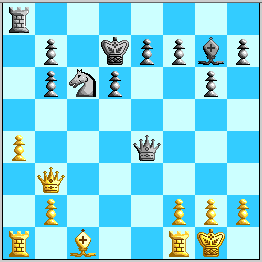
The alternatives offered White no chance of an initiative, for example:
A) 18.Re1 Qb4 19.Ra3, and now either 19…Bd4 or 19...Ne5 looks fine for Black.
B) 18.Be3 Qb4 19.Ra3 Bd4, with a good position for Black.
C) 18.Ra3 Ra5! (19.Qb3 Bd4 20.Be3 Rf5, with good counterplay for Black. Note that 20.Qxf7? loses to 20…Rf5) 19.Rh3 Rd5! 20.Qb3 Na5 21.Qe3 (21.Qxb6?? loses to 21…Bd4) 21...Qxe3, and Black stands well, for example:
C1) 22.fxe3? h5 23.e4 (23.Rxf7? Bf6 wins as the White bishop on c1 is trapped!) 23...Rd4 24.Rxf7 Bf6, and Black is better.
C2) 22.Bxe3 h5 23.Bxb6 Nc4, equal.
The World Team's debate had always been about how Black should best continue after 18.Qb3. This was clearly going to be an important decision for Black. Black's primary options appeared to be the aggressive 18…Nd4 (my original preference when proposing 16…Ne4), the apparently solid 18…e6, and the surprisingly good 18…Bd4!? (for which improvements were found too late to consider this candidate move more seriously). As we shall see, there was a fourth option available for Black - probably the strongest.
Let's look at the original idea of 18…Nd4, and why it was finally decided that this approach was insufficient.
A) 19.Qxb6?? (the Black b-pawn is poisoned) 19…Ra6 (Remember 15...Ra8!?) 20.f3 (20.Qb4 loses to 20…Ne2+) 20...Qd5 21.Qb4 Nc2, and White's queen is trapped.
B) 19.Qh3+ Qf5 20.Qxf5+ (not 20.Qxh7? Ne2+ 21.Kh1 Rh8 22.Qxg7 Rxh2+ 23.Kxh2 Qh5 mate - a variation I had given with my 15…Ra8 proposal. In many variations, White simply cannot take the White h-pawn) 20...Nxf5 and Black is OK.
C) 19.Qxf7 (obviously the critical test), and now:
C1) 19...Bf6!? - Khalifman's idea - to play against the offside White queen. This is an excellent idea that shows nice "feel" for the position and endeavors to seize the initiative. Black threatens Nd4-e6, and Ra8-f8-h8-f8 with a perpetual attack on the White queen.
Unfortunately, White is once again able to use his rook on a1 in a dynamic way (another legacy from 16.a4!) with 20.Ra3! and no matter how Black twists and turns, it appears that White stands better, for example:
C11) 20...Rxa4 21.Rxa4 Ne2+ 22.Kh1 Qxa4 23.Be3 (not 23.Qxh7? Qc4 24.Be3 Ng3+ 25.hxg3 Qxf1+ 26.Kh2 Qb1, and Black wins) 23...Qb5 24.Re1 Qxb2 25.Qd5! Nd4 26.Qxb7+ Ke8 27.Qd5! and White has a clear advantage. One awkward threat is 28.Qxd6!
C12) 20...Nc2 meets with the strong 21.Rf3! and after 21...Ne1 22.Rg3 Be5 23.Bd2! White is better.
C2) 19...Ne6?! fails to 20.Bg5 Nxg5 21.Qxg7 Ne6 22.Qh6! with advantage to White.
As problems persisted with 19…Bf6, attention remained with my original suggestion of 19…Nc2. This may be playable following a tricky series of forced or only moves on both sides, resulting in a tenable ending which will require further precision on Black's part. Let's take a look.
C3) 19...Nc2 20.Bd2! (Instead 20.Ra2? meets with the pretty 20…Ne1!! winning for Black, while 20.Ra3? fails to 20…Nxa3 21.Qxg7 Nc2 22.b3 Ne1!? 23.f3 Qe2 24.Qb2 Qxb2 25.Bxb2 Nd3, and Black has an extra pawn. If 20.Qxg7 Nxa1 21.Bd2, a concern that GM Patrick Wolff communicated to me by e-mail, then Black has 21…Nc2! and everything seems fine) 20...Nxa1 (Alternatives are bad, for example: 20...Bxb2 21.Ra2 Bf6 22.Qb3 Nd4 23.Qxb6, with a plus for White, or 20...Bd4 21.Rab1 Rxa4 22.Qxh7 Qf5 23.Bc3 Bc5 24.Rbd1 Rf4 25.Rd2 Ne3 26.Re1! Nd5 27.Rxd5! Bxf2+ 28.Kh1 Qxd5 29.Qxe7+ Kc6 30.Qe8+ Kc5 31.Rc1! and White wins) 21.Re1 Qh4 (not 21...Qxe1+? 22.Bxe1 Bxb2 23.Qd5, winning for White) 22.Qd5 Rf8 23.Qxb7+ Ke8 24.Qc6+ Kf7 25.Qd5+ Ke8 26.Qb5+ (Protects White's b-pawn) 26...Kf7 27.Rxa1 Qd4 28.Qb3+ Ke8! 29.Be3 Qxb2 30.Qxb2 Bxb2 31.Rb1 Bc3 32.Rxb6 - with an endgame that is possibly tenable for Black. Nevertheless, a tenable endgame did not seem to be the height of Black's aspirations, and we eventually decided to concentrate our efforts elsewhere. The previous variation spelled the end of 18…Nd4 from my viewpoint.
A relatively late entry into the running for selection as Black's 18th move was the interesting 18…Bd4, which had been rehabilitated after 19.Qxf7 with 19…Ra5 (19…Ne5 had been shown to be insufficient after 20.Qb3 Ng4 21.Qb5+!). Here are the main continuations:
A) 20.Ra3? loses to 20…Rf5, threatening 21...Rxf2.
B) 20.Qxh7 Rf5, and now:
B1) 21.Qxg6 is too dangerous for White after 21…Ne5 22.Qh7 Ng4 23.Ra3 (23.Bd2 Nxf2 24.Rxf2 Bxf2+ 25.Kh1 Be1, wins for Black) 23...Qe5 24.Rf3 Rh5 25.Bf4 Rxh7 26.Bxe5 Bxe5, and Black wins.
B2) 21.Be3 (safer) 21...Bxe3 22.fxe3 Qxe3+ 23.Kh1 Rxf1+ 24.Rxf1 Qe2, with level chances.
White can play the less ambitious:
C) 20.Qb3 Rf5, and now:
C1) 21.Be3 Na5 22.Qb4 Rg5 23.g3 (23.Bxg5? Bxf2+ 24.Rxf2 Qxb4, wins for Black) 23...Nc6, with:
C11) 24.Qa3 Rf5, and Black is better.
C12) 24.Qb3 Na5 25.Qb4 Nc6 26.Qb3 Na5, with a draw by repetition.
C2) 21.Bd2 Qe2 22.Be3 Na5 23.Qd1 Qxd1 24.Raxd1 Bxb2 25.Bxb6 Nc4 26.Bd4 b6, and Black has compensation.
So it appears that 18…Bd4!? is a move that can be given serious consideration.
The solid move 18…e6 also attracted much attention. Black defends his weak f7-point and does not allow the disruption of his pawn chain. Instead, Black offers up his weaker pawn on b6 to obtain counterplay in an endgame reminiscent of endgames that can be found in Benko Gambit theory. I suspected that it was these variations that had attracted Alex Khalifman so strongly to 16…Ne4 (Khalifman is a well-known practitioner of the Benko Gambit). In my communications with him, it turned out that Alex was sadly of the opinion that 18…e6 was not sufficient - he was mostly concerned about White's ability to activate his rook with Ra1-a3 in the key lines. Things are not so clear and 18…e6 may be viable. Let's take a look at the main variations.
18...e6!? 19.Qxb6 Nd4, and now:
A) 20.Kh1, with:
A1) 20...Qd5!? 21.Ra3! Ra6 22.Qb4 Nc2 23.Qb5+ Qc6 24.Rf3 Ke8 25.Qxc6+ bxc6 26.b3, with an edge for White.
A2) 20...Ra6 21.Qb4 Qc6 22.Rd1 Rb6 (22...Nc2 23.Qf4, is good for White) 23.Qd2! looks good for White, for example: 23...Nb3 24.Qf4, and White is better.
A3) 20...Qc6 21.Qxc6+ bxc6 22.Ra3! c5 23.Bd2 Nc2 24.Rf3 Ke8 (Possible is 24...f5!? 25.b3 Nd4 26.Rh3 h5 27.Bc3, with an unclear position. I think this endgame playable, but I was concerned about the g6-point being softened up) 25.b3 Nd4 26.Rd3 Rb8 27.Bc3! and White has an edge.
A4) 20...Nc2 21.Qb5+ Qc6 22.Qxc6+ bxc6 23.Ra2 c5 24.b3 Nd4 25.Bb2 Rb8 26.a5 (26.Bxd4 Bxd4 27.Rb1 Rb4!? 28.a5 Kc7 29.Ra4 Rb5 30.a6 Kb8 31.a7+ Ka8 32.Kg1 d5, with compensation for Black) 26...Rxb3 27.a6 Rb8 28.a7 Ra8 29.Rb1 Kc7 30.Bc3 d5 31.Ba5+ Kc8, and I see no way to break down Black's blockade.
B) 20.Bg5!? h6 21.Bd2 (21.Be3 Ra6 22.Bxd4 Rxb6 23.Bxb6 Bxb2, is good for Black), and now:
B1) 21...Qc6 22.Qxc6+ bxc6 23.Ra3! favors White - it was this kind of situation that concerned Khalifman, but instead I offered the improvement:
B2) 21...Ra6 22.Qb4 Ne2+ 23.Kh1 Qxb4 24.Bxb4 Rc6!? and Black has counterplay.
So 18…e6!? seemed playable - requiring exact play and a very refined endgame technique from Black in order to hold the balance.
While the discussions over the relative merits of 18…Nd4, 18…Bd4 and 18…e6 were ongoing, I had been working on an idea that GM Alex Khalifman had communicated to me.
In Alex's words, "If there is something wrong with this, there is something wrong with me." Khalifman's plan, after days of additional scrutiny by the SmartChess Online team, was to become the World Team's weapon against Kasparov.
WT played the dynamic, aggressive and surprising (for Kasparov) move:
18. … f5!
Intensifying the struggle to a new level.
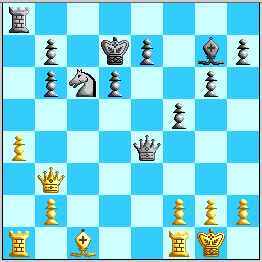
This was my favorite move of the whole game for Black (although I must admit 26…f4 and 10…Qe6 come very close).
Strategically, the move 18…f5! makes a lot of sense:
a) By moving the f-pawn from under attack, Black does not allow White the opportunity of tearing the tapestry of Black's kingside pawn structure apart with Qb3xf7. It is far better to jettison the doubled b-pawn for active piece play and initiative than allow the vital f-pawn (which comprises part of Black's central pawn mass and king shield) to become compromised. By playing 18…f5, Black preserves the integrity of his pawn structure.
b) On f5 this pawn serves the double duty of protecting the queen on e4, and prevents a possible Qb3-h3 check.
c) With the further advance of this pawn to f4, the White rooks and bishop will be deprived the use of the e3-square, and the White rooks and queen will be deprived the use of the g3-square.
d) The further advance to f3 (Supported by the Black queen and knight) could actually lead to an attack on White's king.
From our collaboration with Khalifman and his GM School, we seemed to be well prepared for all eventualities with 18…f5, for example:
A) 19.Be3 Qb4, and now:
A1) 20.Qf7 Qxb2 (also possible is 20...Be5, with the idea f5-f4. Khalifman seemed very much in favor of this center blocking treatment against both 19.Be3 and 19.Bg5 in his notes) 21.Ra2 (21.Rab1 Qf6 22.Qb3 Rc8 23.Qxb6 Rc7 24.Rfd1 f4, with an edge for Black) 21...Qf6 22.Qb3 Qc3 23.Qxb6 Qb4, with an edge for Black.
A2) 20.Qxb4 Nxb4 21.Bxb6, and now either 21…Nd5!? or 21...Nd3, give Black fine counterplay.
B) 19.Ra3 Bd4!? (19...Nd4 is unclear) 20.Be3 Bxe3 21.fxe3 Kc7 22.Raa1 Ra5 23.Rf4 Qd5 24.Qxd5 Rxd5, is equal.
C) 19.Qf7?! Bd4 20.Qxh7 (20.Bg5 Qg4 is fine for Black, when 21.h4? can be met by 21…h6 22.Bxh6 Qxh4 23.Be3 Rh8, and Black wins) 20...Rh8 21.Qxg6 Ne5 22.Qg3 (22.Qg5 Ng4 23.Bf4 Bf6, is good for Black, for example: 24.Rae1 Bxg5 25.Rxe4 fxe4 26.Bxg5 Rxh2 27.f3 Rh5, and Black is winning) 22...Ng4 23.Bf4 (23.h3? loses to 23…Bxf2+) 23...Rxh2 24.Be3 (24.Bg5 Be5 25.Qf3 Qxf3 26.gxf3 Rh5, and Black wins) 24...Be5 25.Qf3 Rh7 26.Qxe4 Bh2+ 27.Kh1 Be5+ 28.Kg1 Bh2+, and Black has at least a draw.
D) 19.Qb5 Bd4!? (19...Qb4 is also possible) 20.Bd2 f4! with fine play for Black.
E) 19.Qxb6 Nd4! 20.Kh1 (20.a5 Ra6 21.f3 Qd5 22.Qb4 b5! with good counterplay for Black), and this position generated a mild difference in opinions. I liked:
E1) 20...Nc2!? 21.Qb5+ Qc6 22.Qxc6+ bxc6 23.Ra2 Nb4 24.Ra3 Nc2 25.Rh3 (25.Ra2 Nb4, equal) 25...Rxa4 26.Rxh7 Bf6, with a "Benko Gambit" type endgame and compensation for Black, while Khalifman preferred:
E2) 20...Qd5!? 21.Ra3 (21.Rd1?! Qb3! 22.Qxb3 Nxb3 23.Ra2 b5! with advantage to Black) 21...Ra6 22.Qb4 Qc6!? 23.Qc3 Qxc3 24.bxc3 Nc6, and Black has compensation planning to reroute the knight with Nc6-a5 to the nice outpost on c4.
After we had finalized our preparation on 18…f5 for the voters, Alex e-mailed me - seemingly alarmed that 19.Bg5 was stronger than he had first suspected. Against 19.Bg5, I offered Alex the possible continuation 19…Qd4 with some analysis as an alternative to 19…Qb4, and everything seemed OK as GM School turned their attention to further analysis of 19…Qd4.
Kasparov played….
19. Bg5
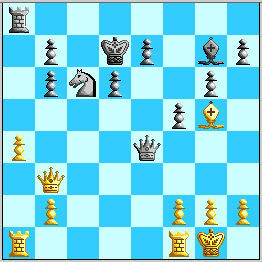
Once again the World Team had to weigh its choices carefully. For example, 19...Nd4?! is bad in view of 20.Qf7 Ne2+ 21.Kh1 Bxb2 22.Ra2! Bd4 23.f3 Qe5 24.Bh4 Bc3 25.Qc4! with a clear advantage for White.
My original plan of 19...Qd4 (followed by applicaton of Khalifman's plan of Bg7-e5 to shield the e-file) was shelved in favor of the game move 19…Qb4. After 19…Qd4, there is:
A) 20.Qf7 Rf8, and Black is better.
B) 20.Rfb1 Qb4 21.Qf7 Be5, with equal chances.
C) 20.Rfe1 Be5, and now:
C1) 21.Re2 Qg4 22.Qxb6 Ra7 23.Rxe5 dxe5 24.Be3 Rxa4 25.Qxb7+ Kd6, and Black has an edge.
C2) 21.Rad1 Qxb2 22.Qf7 Rxa4 23.Qxh7, and now after:
C21) 23...Rg4 24.Qxg6 Nd4, it had been overlooked that White could play 25.Rxd4! (not 25.Rxe5 Nf3+ 26.Kh1 Nxe5 27.Qxf5+ e6 28.Qf8 Rd4, with an edge for Black) 25...Rxd4 (25...Qxd4 26.Qxf5+ e6 27.Qf7+ Kc6 28.Qe8+, and White wins) 26.Qxf5+ Kc7 27.Qh7, with a clear plus for White. It was this oversight that led to 19…Qd4 being shelved. As a result, insufficient resources were assigned to the variation:
C22) 23...Ra2! which may be OK for Black, for example: 24.Rf1! (Defending f2 but releasing the pin on the Be5 against e7) 24…Bd4!? with an unclear game, although the consequences of 25.Qxg6 must be evaluated. So 19…Qd4 might be playable - it's not so clear. Instead the World correctly (in my opinion) chose….
19. … Qb4!
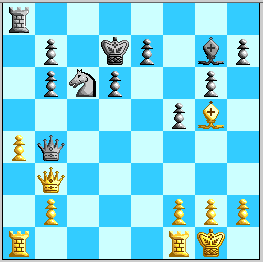
Although I would examine these lines briefly on the Bulletin Boards, we found ourselves returning to the original ideas within the 18…f5 analysis that Khalifman had sent me. The move 19…Qb4! is more forcing and much stronger than 19…Qd4, as White cannot accept an exchange of queens.
20. Qf7
This pressures Black's e7-point and probes Black's kingside while gaining a tempo on Black's undefended bishop on g7. Now 20...Bxb2? is suicide after 21.Rab1 Qg4 22.Bxe7 Nxe7 23.Rxb2 Rxa4 24.Rxb6, and White wins. However, it seems Black can play the very interesting 20…Qxb2!? For example:
C1) 21.Rad1 Rf8 (Black can also play 21...Rxa4 22.Rfe1 Be5, transposing to 19...Qd4 20.Rfe1 Be5 21.Rad1 Qxb2 22.Qf7 Rxa4, examined in a previous note) 22.Qd5 Qe5, and now the queens play "tag" after 23.Qb3 Qb2 24.Qc4 Qc3 25.Qa2 Qb2 26.Qc4 Qc3 27.Qb5 Qb2 28.Qc4 Qc3, and a draw is the likely outcome.
C2) 21.Rfe1 Be5 22.Rad1 (22.Qxh7?? loses to 22…Rh8 23.Qxg6 Bxh2+ 24.Kf1 Bg3 25.Qxf5+ Kd8 26.Kg1 Bxf2+ 27.Qxf2 Rh1+ 28.Kxh1 Qxf2) 22...Rxa4, again transposing to unclear 19...Qd4 continuations.
C3) 21.Rab1 Qd4, and now:
C31) 22.Rbd1 Rf8 23.Qb3 (23.Qxf8 Bxf8 24.Rxd4 Nxd4, favors Black) 23...Qb2, equal.
C32) 22.Rfd1 Rf8 23.Qb3 (23.Qxf8 Qxd1+ 24.Rxd1 Bxf8 25.Rb1 e5 26.Rxb6 Kc7, favors Black) 23...Qg4 24.Be3 f4, and now:
C321) 25.Qxb6 f3 26.Qxb7+ Ke6 27.Qb3+ Kf6 (27...Kd7 28.Qb7+ Ke6 29.Qb3+, with a draw) 28.Kf1 (Black wins after 28.g3 Qh3) 28...Qxg2+ 29.Ke1 Qxh2, with advantage to Black.
C322) 25.h3 Qf5! 26.Qxb6 fxe3 27.Qxb7+ Ke6 28.Qxc6 Qxf2+ 29.Kh1 Rf5 30.Qc4+ Kf6, with level chances.
The move 20…Qxb2!? is interesting and not fully clear. However, all the WT coaches indicated 20…Be5 (Khalifman's original center-blocking strategy starting with 18…f5) and WT seemed fairly well prepared for the likely response - 21.h3!
20. … Be5
21. h3!
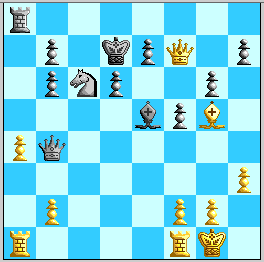
This was the last time a move by Kasparov (e-mailed to the WT coaches) was accompanied by a note - which read, "As predicted by very smart experts I have chosen prophylactic move 21.h3." Indeed, 21.h3 is a very "correct" move. With Black's queen controlling the d2 retreat square for White's bishop, White must be wary of tactical threats involving h7-h6 by Black, for example:
A) 21.Qxh7?? loses to 21…Rh8 22.Qxg6 Bxh2+ 23.Kh1 Qg4.
B) 21.h4? loses to 21…h6!
C) 21.Rfe1? h6 22.Bxh6 Qh4, and Black is better.
D) 21.Rae1 h6!? 22.Bc1 Qh4 23.h3 Qf6 24.Qb3 Ra6, with an edge for Black.
E) 21.Rfd1?! Qg4, with advantage to Black.
However, there are some alternatives that warrant further investigation:
F) 21.Rad1!? and now 21...Qxb2 22.Rfe1 Rxa4 23.Qxh7 Ra2! 24.Rf1! Bd4!? transposes to the unclear position arrived at after 19…Qd4 (see previous analysis). Instead if Black plays 21...Qxa4 22.Rfe1 h6 23.Be3 Qh4 24.h3 Qf6 25.Qb3 Ra6 26.Bxb6 Qe6 27.Qb5 Qf6 28.Bd4 Kc7 29.Bxe5 Nxe5 (29...dxe5 30.Rd7+! Kxd7 31.Qxb7+ Ke8 32.Qxa6, wins for White) 30.Rc1+, White is better. Or if 21...h6 22.Bd2 Qh4 23.h3 Qf6 24.Qb3 Ra6 25.Bc3 Qe6 26.Qb5 Bxc3 27.bxc3 Qa2 28.Ra1 Qd2 29.Rfc1 e6, the position is very unclear.
G) The aggressive 21.f4 is best met by 21...Bxb2 22.Rae1 Re8!? 23.Qxh7 (23.Qe6+ Kc7 24.Qf7 Kd7 25.Qe6+ Kc7, with a draw) 23...Qd4+ 24.Kh1 Qg7, as I analyzed with Kacheishvili, for example, 25.Qxg7 Bxg7 26.Rb1 Bd4 27.Rf3 Ra8 28.Ra3 Ke6! and Florin Felecan further noted the resource 25.Qh3 Bc3! with counterplay.
21. … Rxa4!
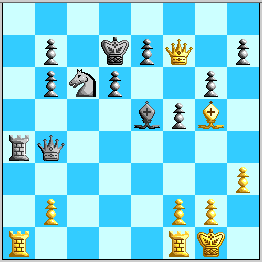
This is the strongest continuation for Black. I had briefly looked at developing the plan with 21…Rh8!? (another idea in conjunction with the sequence 19…Qb4 20.Qf7 Be5 21.h3) to maintain the integrity of Black's kingside with some analysts on the Bulletin Boards (notably Brian McCarthy) and other analysts by e-mail.
My fellow analysts at SmartChess Online who had contributed mightily to working on Khalifman's 18…f5 analysis were somewhat hesitant about 21…Rh8. From my own view, after 21…Rh8, I was not comfortable with Black's position after 22.Rad1 Qxb2 23.Rfe1 (and nobody seemed prepared to disagree with me) and I think White stands better after 23…Qc3 24.f4 Bd4+ 25.Kh1, or 22…f4 23.Rfe1. Nevertheless 21…Rh8!? may be investigated further.
Another possibility was 21…f4, and after 22.Qxh7 Qe4 23.Qf7 Qf5 24.Qxf5+ gxf5 25.Rfb1, we reach an interesting endgame where White has a slight edge but Black should be able to hold with very accurate technical play.
However, true to form, the World chose the most aggressive option with 21…Rxa4! not allowing Kasparov any respite to stabilize the position. This view was shared by two of the other MSN Team coaches, and as a result the move easily won the vote. The forcing 21…Rxa4 was most in the spirit of 18…f5 but had been seen only as a remote possibility at the stage when GM School and SmartChess Online were beginning a new wave of collaboration on behalf of the WT.
22. Rxa4
Probably the best, and certainly most solid continuation for White. White's main alternatives did not seem to offer him much, for example:
A) 22.Rad1 Qc4! 23.Qxh7 Qe6, and now:
A1) 24.f4 Bxb2 25.Rfe1 Re4, good for Black.
A2) 24.b3 Re4! favors Black.
A3) 24.Rfe1 Re4 (interesting is 24...f4!?) 25.Rxe4 (25.f4?? loses to 25…Bd4+) 25...fxe4, with an edge for Black.
B) 22.Rae1 Qc4! 23.Qxh7 Qe6, favors Black, for example: 24.f4 Bd4+ 25.Kh1 Be3! 26.Rf3 Re4.
C) 22.Rab1 Qc4! 23.Qxh7 Qe6 24.Rfe1 f4, with even chances.
D) 22.Rac1 Bxb2 (interesting is 22...f4!?);
D1) 23.Rxc6 Kxc6! (23...bxc6 24.Qxe7+ Kc8 25.Qe8+ Kb7 26.Qd7+ Ka6 27.Qxc6 Qe4 28.Qxd6 Rc4 29.Be3 Qc6, is equal) 24.Qe8+ Kc5 25.Be3+ Kc4 26.Qxe7 d5 27.Qxb7 d4 28.Bg5 Qd6, with a clear advantage for Black.
D2) 23.Rb1 Qc3! 24.Rfe1 (24.Qxh7 Qg7 25.Qxg7 Bxg7 26.Rxb6 Nd8! is equal) 24...Re4 25.Rxe4 fxe4 26.Qxh7 Qg7 27.Qxg7 Bxg7 28.Rxb6 Kc7, with equal chances.
D3) 23.Rce1 Bc3 24.Rxe7+ Nxe7 25.Qxe7+ Kc6 26.Qe8+ Kc5 27.Qc8+ Kb5 28.Qe8+ Kc4 29.Qe6+ Kb5 30.Qe8+ Kc4, with an equal game.
After the text, the next few moves were forced.
22. … Qxa4
23. Qxh7 Bxb2
24. Qxg6 Qe4
Black centralizes his queen to defend his pawn on f5. White has decimated Black's kingside pawn structure. In return, White's queenside has been liquidated. The middlegame now revolves around the relative value of White's passed h-pawn with Black's passed b-pawn.
25. Qf7
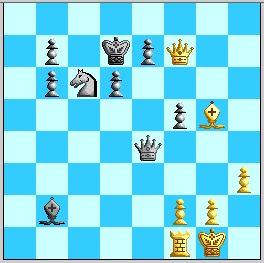
This was not unexpected, but I was much more concerned about the possibility of 25.Be3!? to prevent Black's bishop from returning to a strong central post on d4 (unless Black was willing to acquiesce to an exchange of his strong bishop). This line had undergone a lot of research by IM Antti Pihlajasalo in Finland, who posted as "IM2429." Antti was doing a very good job of worrying me (as usual!) with his findings in this line.
After 25.Be3!? then 25…Nd4 (seems best to me. Instead 25…b5 allows the strong 26.g4), and now:
A) 26.Qh7 Ne2+ 27.Kh1 Bc3, with counterplay for Black.
B) 26.Bxd4 Bxd4 27.g4 Bxf2+! 28.Rxf2 (28.Kxf2 Qd4+ 29.Ke2 Qe4+, with a draw) 28...Qe1+ 29.Kg2 Qe4+, with a draw.
C) 26.Qh5 b5, with counterplay for Black.
D) 26.Qg8 b5, with counterplay for Black.
All in all, I am not sure that we were well enough prepared to meet 25.Be3.
Other White alternatives did not seem so threatening, for example:
25.h4 Bd4! and now:
A) 26.h5 Ne5 27.Qh7 (27.Qg7? loses to 27…Ng4) 27...Ng4 28.Bh4 Qe5 29.Rd1 Bc5! with an excellent game for Black.
B) 26.Qf7 b5! and now:
B1) 27.h5 b4 28.h6 Qe6 29.Qxe6+ Kxe6, and Black has good counterchances in this unclear endgame, for example:
B11) 30.Bd2 Kf7 31.Rb1 Bc3 32.Be3 (32.Bxc3? loses to 32…bxc3 33.Rc1 Nd4 34.Kf1 c2 35.Ke1 b5) 32...d5, or;
B12) 30.Rb1 Bc3, with the idea 31.Bc1 Kf7 32.Bb2 (32.Kf1 Kg6 33.Ke2 e5, is good for Black) 32...Bxb2 33.Rxb2 Kg6, and Black is better.
B2) 27.Qb3 is better, and after 27…b4 28.h5 (28.Rd1 e6!? favors Black) 28...Qg4 29.Bd2 (29.Be3? Qxh5 30.Bxd4 Nxd4, and Black wins) 29...Qxh5 30.Bxb4 Be5, with equal chances.
The interesting and independent analysis of Ross Amann was critical to the assessment of several of these lines.
25.f3 is adequately met by 25…Bd4+ (25...Qd5!?) 26.Kh1 Qd5, with a plus for Black.
Instead, 25.Qg8 Bd4 26.Qb3 f4, transposes to the game.
25. … Bd4
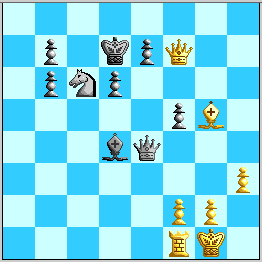
Relocating the bishop to a powerful central square.
Alternatives are not so good, e.g., 25...d5 26.Rd1 Bd4 27.Kf1 Qe6 (27...b5 28.Re1 Qd3+ 29.Kg1 Bc5 30.Qe6+ Kc7 31.Bf4+ Kb6 32.Qd7, is good for White) 28.Qf8 Qe4 29.Re1 Qd3+ 30.Kg1 Bc5 31.Qf7, with a pull for White.
Or 25...Nd4 26.h4 Bc3 27.h5 Ne2+ 28.Kh1 Bd2 29.Bxe7 Qxe7 30.Qxf5+ Kc7 31.g3, and White is better.
26. Qb3
Before undertaking any further pawn advance on the kingside, Kasparov takes prophylactic measures against Black's queenside counterplay.
If 26.h4 b5! 27.h5 b4 28.h6 Qe6 29.Qxe6+ Kxe6, transposes to a position already seen to be fine for Black.
26. … f4!
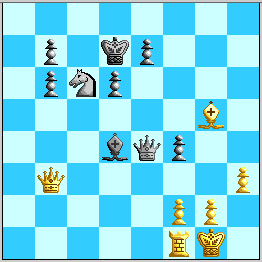
A very strong and deep strategic move first suggested by a person who went by the anonymous name of "Yasha" (Yaaqov Vaingorten). Originally, we had focussed on the idea of 26...Bc5, to lend extra defense to the Black king and to maintain pressure on White's f2-point. Unfortunately, White has a strong plan to counter this, which involves bringing his bishop to e3 to challenge Black's important bishop.
After 26…Bc5, White plays 27.Qb1! and now:
A) 27...Qe6 28.Re1 Qg6 29.Be3 Kc7 30.Qb5 e5 31.Rb1 Nd4 32.Bxd4 Bxd4 33.Qd5 Bc5 34.Rb2, with a clear advantage for White.
B) 27...Qxb1 28.Rxb1 d5 29.h4! e5 30.h5, or:
C) 27...Qd5 28.h4 b5 29.Rd1 Qe5 30.Re1 Qd5 31.Be3! b4 (31...Bxe3 32.Rxe3, is good for White) 32.Rd1 Qe5 (32...Nd4 33.Bxd4 Bxd4 34.Qd3 e5 35.Qxf5+ Kc7 36.Rc1+ Kb6 37.h5, with advantage to White) 33.Bxc5 Qxc5 34.h5 Nd4 35.Rd2 e5 36.h6, are good for White.
The strong move 26…f4! was designed to prevent this plan of Bg5-e3 by White, and its attendant variations were fine-tuned by various analysts on the Bulletin Boards. After the original suggestion of 26…f4 appeared on the Bulletin Boards, I asked GM Ron Henley to examine certain specific "worry" variations in detail. Without the important solutions Henley found in an overnight analysis session, I am not certain that I would have had such confidence in recommending 26…f4 to the voters.
The World Champion appears to believe that "Irina Krush" is/was a pseudonym for an army of strong grandmasters assembled in secret to defeat him. Nothing could be further from the truth. Certainly, I interacted with my trainers - GM Henley and GM Kacheishvili - and from time to time GM Khalifman at the GM School in St. Petersburg. But it should be remembered that GM School in St. Petersburg was (understandably) not active at full strength for a long period while its big guns (Khalifman and Sakaev) were playing at the FIDE World Championships in Las Vegas. In fact, in some respects "Irina Krush" was a pseudonym for the World Team Bulletin Boards. None of the other MSN analysts had seemed interested in interacting on the Bulletin Boards - and the task somehow became mine, probably due more to my own enthusiasm than any other reason. It has been argued that because the way the event was designed, that without some conduit (in this case me) between the Bulletin Boards and the general (and casual) voting public that made up about 90-95% of the vote, then the work on the Bulletin Boards would have been wasted. If this experiment is ever repeated under the same mechanism, the organizers have a responsibility to locate an analyst who will take on such a role.
So that the World Champion is a little clearer on who some of his opposition was - the strongest regular posters of analysis on the WT Bulletin Boards were IM Antti Pihlajasalo and IM Ken Regan (a "lurker" until move 33, until a pair of important e-mails came my way at the end of August). However in my opinion both of these people are grandmasters of analysis!
27. Qf7
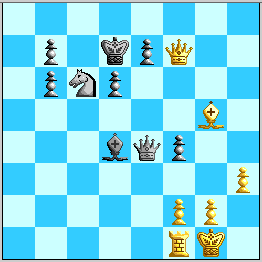
Attacking the f4-pawn. This is the best move as 27.h4 Ne5! would give Black excellent play, while 27.Qd1 allows the disruptive 27…f3! with initiative for Black.
Finally 27.Qb1 can be met with 27…Bxf2+! 28.Kh1 Qxb1 29.Rxb1 e5 30.h4 Ke6, with at least even chances for Black.
27. … Be5
Simple and good - protecting the f-pawn. Now Kasparov could have taken a draw by repetition with 28.Qb3 Bd4 29.Qf7 Be5, but it did not seem likely to me that he would end this historic event in such a tame manner.
28. h4
The only way to fight for the initiative. Perhaps Kasparov was as relieved as the World Team to have survived the complications thus far, and was now prepared to put a new face on the game.
28. … b5
Black's b-pawn represents his counterplay, so its advance must not be delayed any further. This advance opens up the possibility of Black opposing queens with Qe4-c4.
29. h5 Qc4!
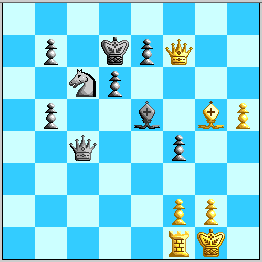
This provocative move (popular with the analysts) has come under some criticism but I fail to see why as it leads to a position in which Black absolutely does not stand worse. GM Etienne Bacrot had indicated a preference for 29…Qe2 (as did GM Duncan Suttles), and we later became aware that Kasparov himself said he could find no advantage after 29…Qe2. However, we were also unable to find any advantage for White after 29…Qc4! Other GMs like Khalifman, Henley and Ilya Gurevich (and then later also Bacrot) preferred 29…Qc4 - as none appeared to dislike Black's counterchances after 30.Qf8, or the endgame following 30.Qf5+ Qe6 31.Qxe6+ Kxe6.
After 29…Qe2, the most important position is reached after the straightforward 30.Bxf4 Bxf4 31.Qxf4 Qxh5, when Black has allowed the exchange of his beautiful bishop but traded White's h-pawn for the weaker Black f-pawn. I was uncertain about Black's counterplay (without a bishop) being sufficient to offset White still having a potentially dangerous g-pawn. I absolutely believe that 29…Qc4! is the correct move for Black in this position.
For 29…Qc4, the World Team had carefully prepared for the complex middlegame that would result from 30.Qf8 b4! 31.h6 b3 32.Qf5+ e6! (a nice move which was one of the most important contributions to the World Team's efforts by computers!) when Black's chances had been determined to be no worse. Here is just a taste of the pretty lines discovered after 32…e6. For example:
33.Qf7+ Kc8 34.Bf6 b2 35.Qg8+ (35.Bxe5? loses to 35…Qxf1+!) 35…Kc7 36.Qh7+ Kb8 37.Bxe5 Bxe5, and now:
A) 38.Qb1? f3! 39.h7 Qh4 40.Qxb2 fxg2 41.h8=Q+ Qxh8 42.Kxg2 Qg7+ 43.Kh1 Qh6+ 44.Kg2 Qg5+ 45.Kh1 Qh4+ 46.Kg2 Qg4+ 47.Kh1 Qh3+ 48.Kg1 Nf3 mate!
B) 38.f3 Nxf3+ 39.gxf3 (39.Rxf3 Qc1+ 40.Rf1 Qc5+, with a draw) 39…Qc5+ 40.Kh2 Qh5+ 41.Kg2 Qg5+ 42.Kf2 Qc5+ 43.Ke2 Qe3+ 44.Kd1 Qc1+, with a draw.
30. Qf5+
A very sensible and practical decision - as White has some chances for an initiative in the following endgame. Objectively, the endgame that follows appears to be a draw - albeit a very lively and complicated draw. Nevertheless, the ensuing endgame could not be taken lightly, as I felt sure that Kasparov would feel his chances of inducing a weak move by the World Team would be enhanced in a technical endgame scenario.
30. … Qe6
31. Qxe6+ Kxe6
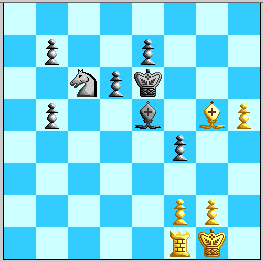
In the moves that follow, we will see how the World Team, despite passing up a number of interesting (and also complicated) alternatives along the way, fought to reach a greatly simplified, yet phenomenally complicated queen ending.
I think you will be amazed at how well the World Team fought the World Champion under some very difficult circumstances. One could say it is the "stuff" of legends.
This completes Part I of the
three-part article. The
continuation is here.